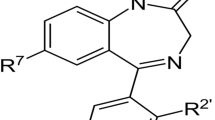Abstract
Benzodiazepines have found wide therapeutic application in the treatment of anxiety, sleep disorders, muscle spasms and convulsions. In the present report we describe recent progress in the clarification of the mechanism of action of benzodiazepines: benzodiazepines are bound to a specific target structure in the brain, termed benzodiazepine receptor, in order to elicit their pharmacological and therapeutic central effects. The receptor is characterized by a binding site highly specific for benzodiazepines. In addition to the identification, characteristics and distribution of the benzodiazepine receptor in normal human brain, its alteration in Huntington’s disease are described. Furthermore, present views on the biochemical mechanism of action of benzodiazepine are discussed.
Access this chapter
Tax calculation will be finalised at checkout
Purchases are for personal use only
Preview
Unable to display preview. Download preview PDF.
Similar content being viewed by others
References
Bird, E. D. and Iversen, L. L. (1974). Huntington’s chorea: postmortem measurement of glutamic acid decarboxylase, choline acetyltransferase and dopamine in basal ganglia. Brain, 97, 457–472
Braestrup, C., Nissen, C., Squires, R. F., Schousboe, A. (1970). Lack of brain specific benzodiazepine receptors on mouse primary astroglial cultures. Neurosa. Lett., 9, 45–49
Braestrup, C. and Squires, R. F. (1977). Specific benzodiazepine receptors in rat brain characterized by high-affinity 3H-diazepam binding. Proc. Natl. Acad. Sci. USA, 74, 3805–3807
Braestrup, C., Albrechtsen, R. and Squires, R. F. (1977). High densities of benzodiazepine receptors in human cortical areas. Nature, 269, 702–704
Chang, R. S. L. and Snyder, S. H. (1978). Benzodiazepine receptors: labelling in intact animals with 3H-flunitrazepam. Eur. J. Pharmacol., 48, 213–218
Davies, J. and Pole, P. (1978). Effect of a water-soluble benzodiazepine on the responses of spinal neurones to acetylcholine and excitatory amino acid analogues. Neuropharmacology, 17, 217–220
Feldman, R. (1978). Discriminative properties of chlordiazepoxide: a new method of analysis. Psychopharmacology, 58 (2), p. 6, Abstr. No. 13
File, S. A. and Vellucci, S. V. (1978). Studies on the role of ACTH and 5-HT in anxiety, using an animal model. J. Pharm. Pharmacol., 30, 105–110
Gottschalk, L. A. and Elliott, A. W. (1976). Effects of triazolam and flurazepam on emotions and intellectual function. Res. Commun. Psychol., Psychiatr. Behav., 1, 575–595
Guidotti, A., Toffano, G. and Costa, E. (1978). An endogenous protein modulates the affinity of GABA and benzodiazepine receptors in rat brain. Nature, 275, 553–555
Haefely, W., Pole, P., Schaffner, R., Keller, H. H., Pieri, L. and Möhler, H. (1978). Facilitation of GABAergic transmission. In H. Kofod, P. Krogsgaard-Larsen and F. Scheel-Krüger (eds.), GABA Neurotransmitters. (In press)
Instructions for medical use provided by the manufacturers on the product information sheet of the commercially available drugs
Karobath, M. and Sperk, G. (1979). Stimulation of benzodiazepine receptor binding by γ-aminobutyric acid. Proc. Natl. Acad. Sci. USA. (In press)
Möhler, H. and Okada, T. (1977). Benzodiazepine receptor: demonstration in the central nervous system. Science, 198, 849–851
Möhler, H. and Okada, T. (1977). Properties of 3H-diazepam binding to benzodiazepine receptors in rat cerebral cortex. Life Sci., 20, 2101–2110
Möhler, H., Okada, T. and Bird, E. (1978). Huntington’s chorea: decrease in benzodiazepine-receptor binding. 7th Int. Congress of Pharmacology, Paris, Abstr. No. 2536
Möhler, H., Okada, T., Ulrich, J. and Heitz, Ph. (1978). Biochemical identification of the site of action of benzodiazepines in human brain by 3H-diazepam binding. Life Sci., 22, 985–996
Möhler, H., Pole, P., Cumin, R., Pieri, L. and Kettler, R. (1979). Nicotinamide or brain constituent with benzodiazepine-like action. Nature. (In press)
Nistri, A. and Constanti, A. (1978). Effects of flurazepam on amino acid evoked responses recorded from the lobster muscle and the frog spinal cord. Neuropharmacology, 17, 127–135
Okada, T., Spokes, E. G., Bird, E. D. and Möhler, H. (1979). Huntington’s chorea: decrease in benzodiazepine-receptor binding in putamen and caudate nucleus. (In preparation)
Okada, T. and Möhler, H. Ligand specificity of the brain benzodiazepine receptor. (In preparation)
Pegram, V., Robinson, C., Donaldson, P., Beaton, J. and Smythies, J. (1975). The effects of chronic use of nicotinamide on human sleep. 2nd Int. Congr. on Sleep Research, Edinburgh, Abstr., p. 91
Randall, L. O., Schallek, W., Sternbach, L. H. and Ning, R. Y. (1974). Chemistry and pharmacology of the 1,4-benzodiazepines. In M. Gordon (ed.), Psychopharmacological Agents, Vol. III, pp. 175–281
Robinson, C. R., Pegram, G. V., Hyde, P. R., Beaton, J. M. and Smythies, J. R. (1977). The effects of nicotinamide upon sleep in humans. Biol. Psychiatry, 12, 139–143
Squires, R. F. and Braestrup, C. (1977). Benzodiazepine receptors in rat brain. Nature, 266, 732–734
Tallman, J. F., Thomas, J. W. and Gallager, D. W. (1978). GABAergic modulation of benzodiazepine binding site sensitivity. Nature, 274, 383–385
Toffano, G., Guidotti, A. and Costa, E. (1978). Purification of an endogenous protein inhibitor for the high-affinity binding of gamma-aminobutyric acid to synaptic membranes of rat brain. Proc. Natl. Acad. Sci. USA, 75, 4024–4028
Williamson, M. J., Paul, S. M. and Skolnick, P. (1978). Labelling of benzodiazepine receptors in vivo. Nature, 275, 551–553
Editor information
Editors and Affiliations
Rights and permissions
Copyright information
© 1979 MTP Press Limited
About this chapter
Cite this chapter
Möhler, H., Okada, T. (1979). The Benzodiazepine Receptor in Human Brain. In: Priest, R.G., Pletscher, A., Ward, J. (eds) Sleep Research. Springer, Dordrecht. https://doi.org/10.1007/978-94-011-6226-5_1
Download citation
DOI: https://doi.org/10.1007/978-94-011-6226-5_1
Publisher Name: Springer, Dordrecht
Print ISBN: 978-94-011-6228-9
Online ISBN: 978-94-011-6226-5
eBook Packages: Springer Book Archive




